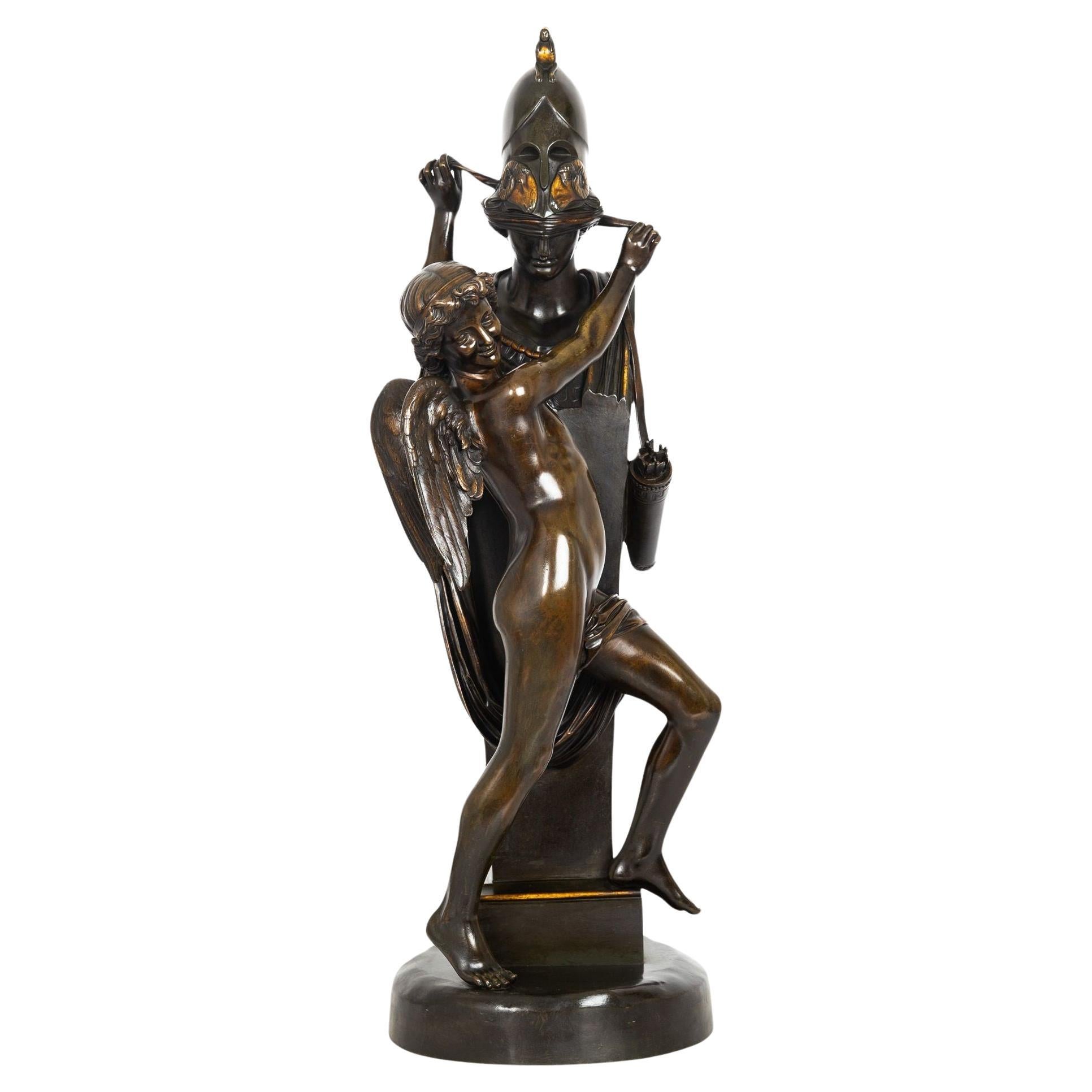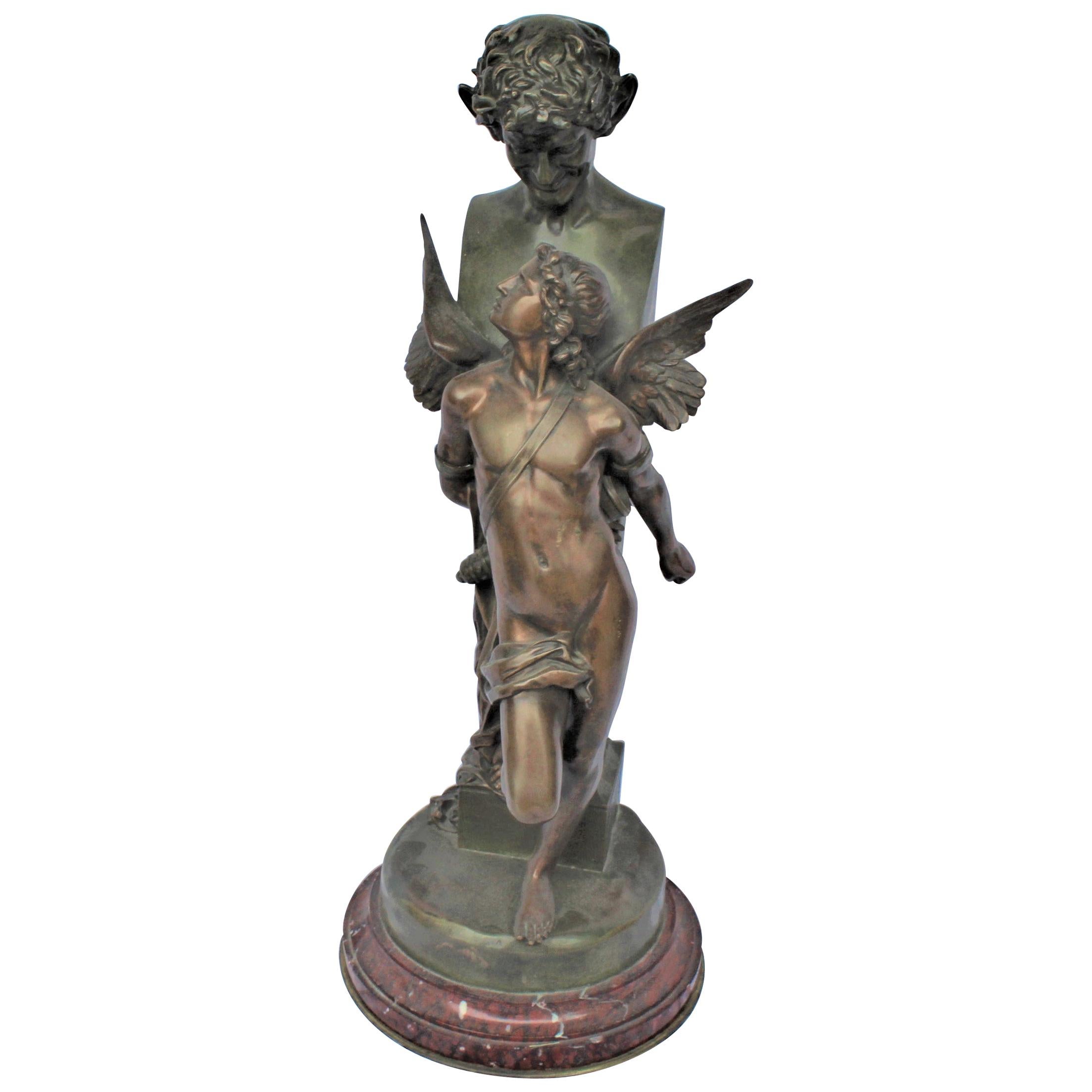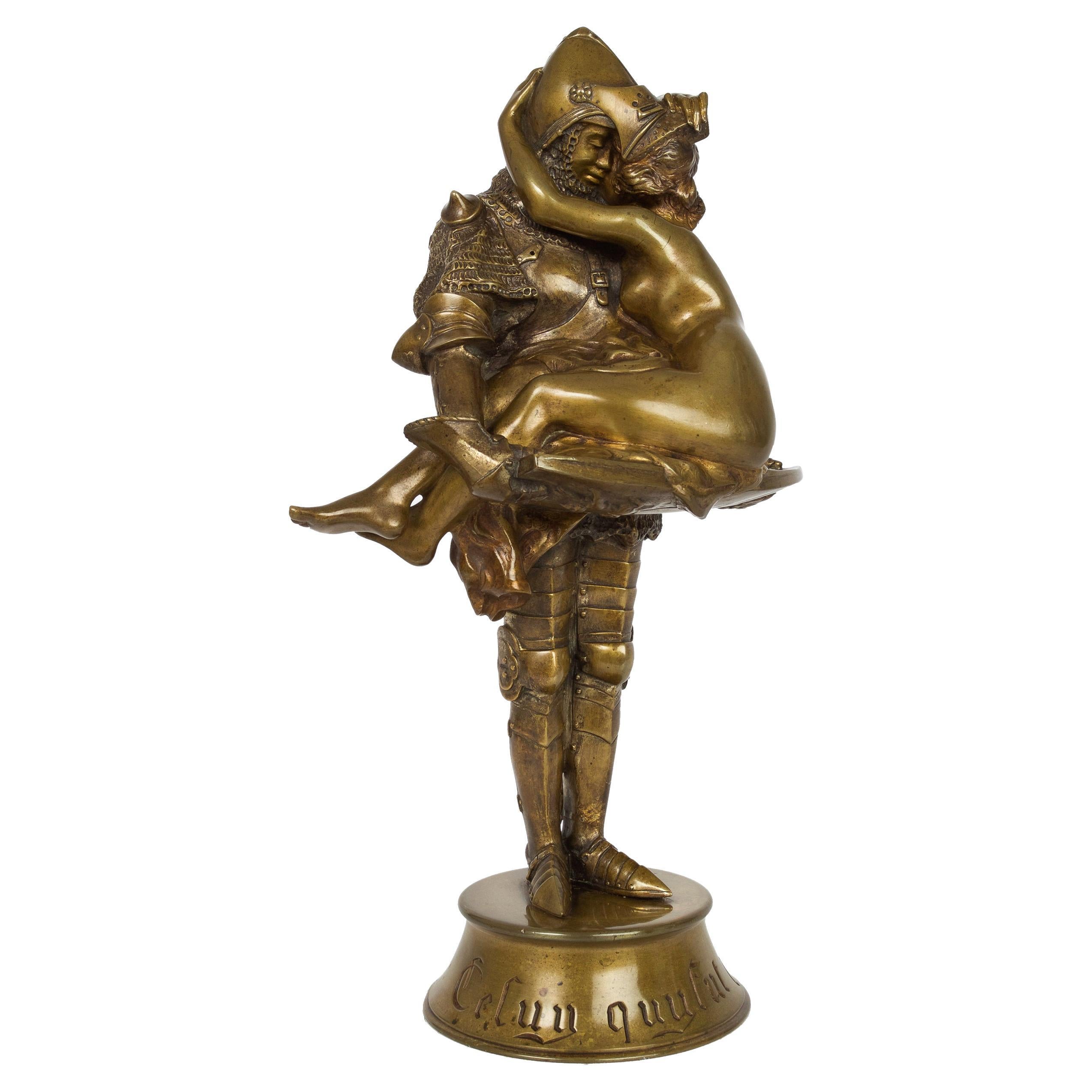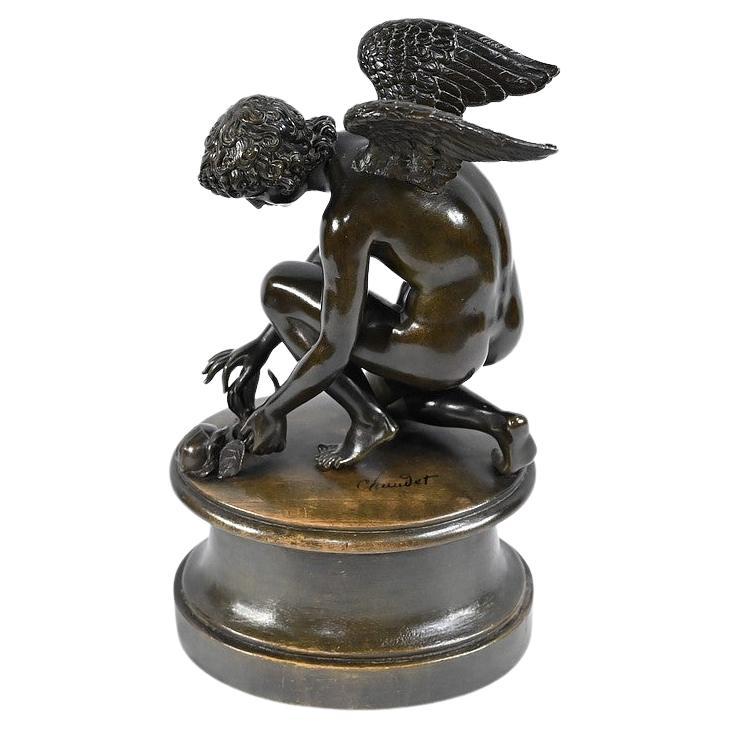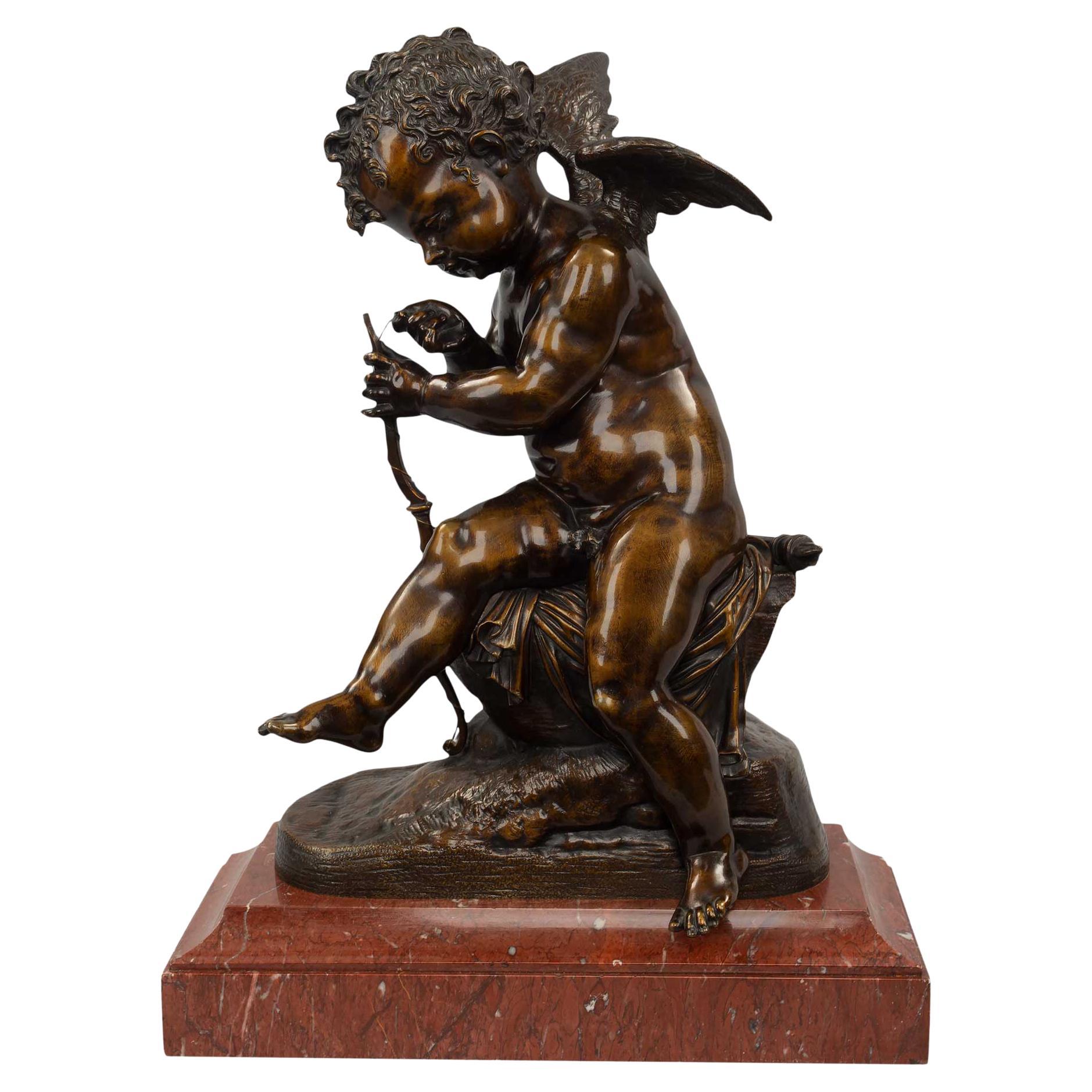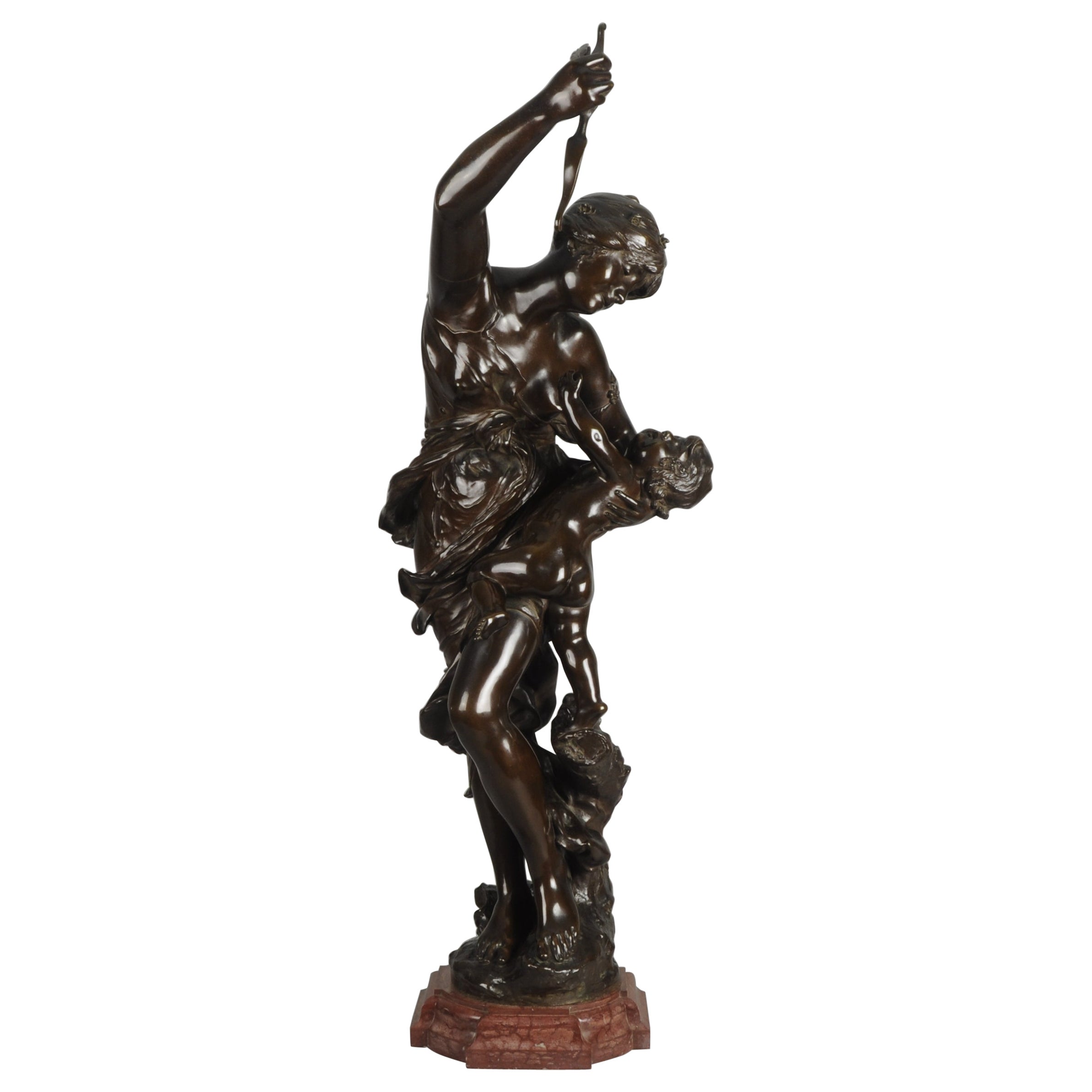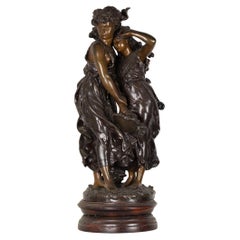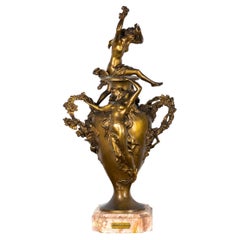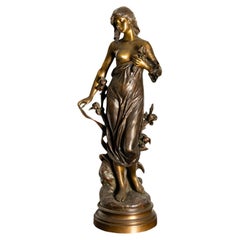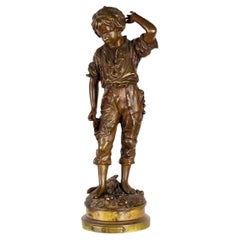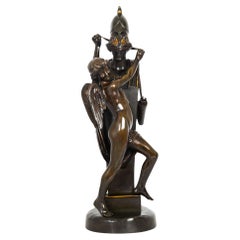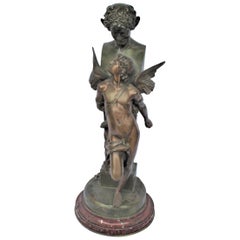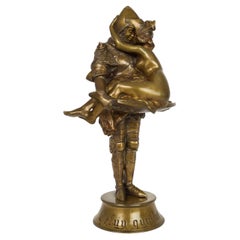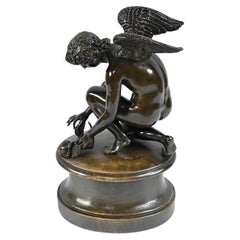Items Similar to Amour Captif Bronze Statue By Félix Sanzel, 20th Century
Video Loading
Want more images or videos?
Request additional images or videos from the seller
1 of 13
Amour Captif Bronze Statue By Félix Sanzel, 20th Century
$7,347.01
$9,183.7720% Off
£5,432.89
£6,791.1120% Off
€6,152
€7,69020% Off
CA$10,091.84
CA$12,614.7920% Off
A$11,221.54
A$14,026.9320% Off
CHF 5,874.68
CHF 7,343.3520% Off
MX$137,073.23
MX$171,341.5320% Off
NOK 73,821.14
NOK 92,276.4220% Off
SEK 69,443.57
SEK 86,804.4720% Off
DKK 46,842.74
DKK 58,553.4320% Off
About the Item
This patinated bronze sculpture titled Amour Captif is a powerful reinterpretation of love's paradoxes, created by celebrated French sculptor Félix Sanzel.
Signed F. Sanzel on the base, the work bears the inscription: "Amour Vainqueur par F. Sanzel Statuaire, Médaille d’or au Salon", referencing its original marble version exhibited at the Paris Salon of 1868, where Sanzel was awarded the prestigious Gold Medal.
In this evocative piece, a youthful Cupid — or "Love" personified — is shown not as a mischievous controller of others’ hearts, but as a captive himself, bound to the bust of the god Termes.
The dynamic between the figures blurs the lines between seduction and submission, desire and restraint.
Crafted with remarkable anatomical detail, the sculpture balances neoclassical form with a deeply symbolic narrative, enhanced by its rich patina and solid red marble base.
Take into account that the colors on the items may vary depending on the type of lighting and the type of screen from which you see the images.
- Creator:Felix Sanzel (Sculptor)
- Dimensions:Height: 19.1 in (48.5 cm)Diameter: 6.7 in (17 cm)
- Style:Art Nouveau (Of the Period)
- Materials and Techniques:
- Place of Origin:
- Period:
- Date of Manufacture:Circa 1870
- Condition:Wear consistent with age and use. Minor losses. Light scratches compatible with the age.
- Seller Location:Lisbon, PT
- Reference Number:Seller: 96571stDibs: LU9157245212982
About the Seller
5.0
Gold Seller
Premium sellers maintaining a 4.3+ rating and 24-hour response times
Established in 2023
1stDibs seller since 2023
10 sales on 1stDibs
Typical response time: <1 hour
- ShippingRetrieving quote...Shipping from: Lisbon, Portugal
- Return Policy
Authenticity Guarantee
In the unlikely event there’s an issue with an item’s authenticity, contact us within 1 year for a full refund. DetailsMoney-Back Guarantee
If your item is not as described, is damaged in transit, or does not arrive, contact us within 7 days for a full refund. Details24-Hour Cancellation
You have a 24-hour grace period in which to reconsider your purchase, with no questions asked.Vetted Professional Sellers
Our world-class sellers must adhere to strict standards for service and quality, maintaining the integrity of our listings.Price-Match Guarantee
If you find that a seller listed the same item for a lower price elsewhere, we’ll match it.Trusted Global Delivery
Our best-in-class carrier network provides specialized shipping options worldwide, including custom delivery.More From This Seller
View AllProtection Bronze Sculpture by Francois Moreau, 19th Century
By Hippolyte François Moreau
Located in Lisbon, PT
A bronze statue, two girls with the loose tunic in the wind hugging each other - Persephone the Goddess of Protection embraces the smallest girl in an act of protection.
Possesses a...
Category
Antique 19th Century French Neoclassical Figurative Sculptures
Materials
Bronze
$7,053 Sale Price
33% Off
Gilt-bronze Battle Of The Flowers Statue by Félix Charpentier, 20th Century
By Félix Charpentier, Jollet & Cie
Located in Lisbon, PT
Félix Charpentier's masterpiece, 'Bataille des fleurs,' is a stunning golden bronze statue with a beautiful gilded patina finish.
It draws inspiration from the colorful Carnival fe...
Category
20th Century French Art Nouveau Figurative Sculptures
Materials
Marble, Bronze
$16,164 Sale Price
20% Off
Diana Bronze Sculpture by Drouot, Napoleon III, 19th Century
By Vrai Bronze B.D., Edouard Drouot
Located in Lisbon, PT
A powerful 19th-century bronze sculpture of the Roman goddess of the hunt, Diana, captured mid-motion by the celebrated French artist Edouard Drouot.
This patinated bronze figurine ...
Category
Antique 19th Century French Napoleon III Figurative Sculptures
Materials
Bronze
$17,633 Sale Price
20% Off
French Bronze, Boy Sculpture, Charles Anfrie, 19th Century
By Vrai Bronze B.D., Charles Anfrie
Located in Lisbon, PT
This 19th-century bronze sculpture titled "Un Accident" captures a moment of innocent confusion through the detailed depiction of a barefoot boy in rustic clothing, scratching his he...
Category
Antique 19th Century French Napoleon III Figurative Sculptures
Materials
Metal, Bronze
$5,667 Sale Price
20% Off
Grand Tour Bronze Statue Of Atalanta, Thiébaut Freres
By Fumiére et Cie, Thiebaut Freres
Located in Lisbon, PT
Small french bronze sculpture of the mythological huntress Atalanta, cast by the iconic Thiébaut Frères foundry during its final years as “Thiébaut Frères, Fumière et Cie” (1920–1926...
Category
20th Century French Grand Tour Figurative Sculptures
Materials
Marble, Bronze
$1,762 Sale Price
20% Off
Bronze Sculpture Eurydice by Eugène Marioton Woman, 19th Century
By Eugene Marioton
Located in Lisbon, PT
Eurydice, one of the Nereids, is depicted in a bronze statue from the 19th century. Her long hair flows freely amidst a rocky landscape and she wears a conch shell as an earring. The...
Category
Antique Late 19th Century French Belle Époque Figurative Sculptures
Materials
Bronze
$13,645 Sale Price
20% Off
You May Also Like
“Love Conquers” French Bronze Sculpture by Felix Sanzel circa 1870
Located in Shippensburg, PA
FELIX SANZEL
French, 1829-1883
"L'Amour vainqueur" [Love Conquers] (1865)
Patinated and burnished bronze signed in cast "Fx Sanzel" a lifetime cast circa 1870
Item # 306PRK21E
An ...
Category
Antique 19th Century French Romantic Figurative Sculptures
Materials
Bronze
Bronze Sculpture, Double Figure, Antique, Signed F Sanzel Large
Located in Los Angeles, CA
A large sculpture of angel in bondage held by the Devil image. Great patinas and mounted on red marble with brass bottom plate. Has the signature F...
Category
Antique 1890s European Art Nouveau Figurative Sculptures
Materials
Bronze
French Antique Art Nouveau Bronze Sculpture of Knight by François A. Clémencin
Located in Shippensburg, PA
FRANÇOIS ANDRÉ CLÉMENCIN
French, 1878-1950
"Celui qui fut pris" (The one that was taken)
Patinated & polychromed bronze Signed on base "A. Clemencin"
Item # 110BKP22X
An exquisi...
Category
20th Century French Art Nouveau Figurative Sculptures
Materials
Bronze
Bronze sculpture “Love”, signed A-D.Chaudet – 19th century
By Chaudet
Located in HÉRIC, FR
Neoclassical bronze sculpture with brown patina, entitled "Love," also known as "Love Taking a Butterfly," signed Antoine-Denis Chaudet (1763-1810) on the terrace.
Chaudet was a Fren...
Category
Antique 19th Century French Figurative Sculptures
Materials
Bronze
French 19th Century Patinated Bronze Statue, after Charles Gabriel Lemire
By Charles G. Lemire
Located in West Palm Beach, FL
A charming and very elegant French mid 19th Century patinated bronze statue of a cherub, after Charles Gabriel Lemire. The statue is raised by a rectangular Rouge Griotte marble base...
Category
Antique 19th Century French Figurative Sculptures
Materials
Marble, Bronze
19th Century Art Nouveau Bronze Entitled "Venus & Cupid" by Jean Sul-Abadie
By Jean Abadie
Located in London, GB
A very fine bronze study of Venus taking an arrow from Cupid her son, who at times would shoot his arrows without meaning or reason into the hearts of men, igniting their desire. Exhibiting excellent rich brown patina and good detail, signed Sul Abadie and stamped.
Additional information
Height: 93 cm
Condition: excellent condition
Circa: 1885
Materials: bronze & marble
SKU: 4979
ABOUT
Jean Sul-Abadie
Jean Sul-Abadie (Born 1850 ~ Died 15th April 1890) was a French artist, a pupil of Jouffroy and Falguière. Specialising in bronze sculpting in the Art Nouveau style. He made his Salon debut in 1872.
Cupid & Venus
Different tales exist about the origin of Venus and Cupid. Some say that Venus, the goddess of love and beauty, had a love affair with Mars, the god of war. Out of this relationship, Cupid was born. In the following painting you see Venus with Mars, who is being disarmed by Cupid.
Cupid has attributes from both of his parents. Like his mother he is considered to be the god of love, or more precisely, the god of falling in love. He is portrayed as an innocent little child with bow and arrows. He shoots arrows to the heart, and awakening a love that you’re powerless to resist.
In classical mythology, Cupid (Latin Cupido, meaning “desire”) is the god of desire, erotic love, attraction and affection. He is often portrayed as the son of the love goddess Venus and the war god Mars, and is known in Latin also as Amor (“Love”). His Greek counterpart is Eros.
Although Eros is in Classical Greek art as a slender winged youth, during the Hellenistic period, he was increasingly portrayed as a chubby boy. During this time, his iconography acquired the bow and arrow that represent his source of power: a person, or even a deity, who is shot by Cupid’s arrow is filled with uncontrollable desire. In myths, Cupid is a minor character who serves mostly to set the plot in motion. He is a main character only in the tale of Cupid and Psyche, when wounded by his own weapons he experiences the ordeal of love. Although other extended stories are not told about him, his tradition is rich in poetic themes and visual scenarios, such as “Love conquers all” and the retaliatory punishment or torture of Cupid.
In art, Cupid often appears in multiples as the Amores, or amoriniin the later terminology of art history, the equivalent of the Greek erotes. Cupids are a frequent motif of both Roman art and later Western art of the classical tradition. In the 15th century, the iconography of Cupid starts to become indistinguishable from the putto.
Cupid continued to be a popular figure in the Middle Ages, when under Christian influence he often had a dual nature as Heavenly and Earthly love. In the Renaissance, a renewed interest in classical philosophy endowed him with complex allegorical meanings. In contemporary popular culture, Cupid is shown drawing his bow to inspire romantic love, often as an icon of Valentine’s Day.
Venus is the Roman goddess whose functions encompassed love, beauty, sex, fertility, prosperity, victory, and desire. In Roman mythology, she was the mother of the Roman people through her son, Aeneas, who survived the fall of Troy...
Category
Antique Late 19th Century French Art Nouveau Figurative Sculptures
Materials
Breccia Marble, Bronze
More Ways To Browse
Medaille Bronze
Gold Bear Statue
Cupid Statues
Wooden Articulated Hand
Antique Fire Hat
Australian Wood Carving
Europa And Bull
Lladro Figurines Used
Muses Statues
Plaster Maquette
Praying Statue
Rene Lalique Hood Ornaments
Robert Napoleon
Rosenthal Figurines
Vintage Hat Display Heads
Antique Car Ornaments
Antique Porcelain Soldiers
Antique Wood Mannequin
